 From the Executive Chair From the Executive Chair
A Fond Farewell
For some reason the "Ask not....." statement of President John F. Kennedy has been on my mind lately. You may wonder how that relates to the Currier Museum. Well, we all know what an unexpected jewel the Currier is in Manchester, but many people close by have not yet discovered that jewel.
Most of us have had the experience of speaking with someone in or around Manchester, and found the person might have heard of the Currier, but has never been inside the door. How many of us have asked visitors where they are from only to hear they were born and raised in Manchester, yet "this is the first time" they have visited?
We all have friends who say: "I really must join," but they haven't done so. We all know what the Currier does for us in so many wonderful ways, but we should think about what we can do for the Currier. We all enthusiastically volunteer countless hours and I would like to suggest another way we can really help the museum.
If you know of someone who you think would like to be a member, invite them to one of our many events. Advancement Assistant and Internal Events Coordinator Michelle Thornton would be happy to tell you of scheduled events and our membership department would be happy to make whatever contact you think might encourage a friend to join. The Advisory Council works hard to schedule interesting and exciting events, and potential members are always welcome.
Another way you can recruit for the Currier is to consider becoming a member of the Currier Society. You may not know a lot about the benefits of being a Society member, but here are just a few:
- free admission at 13 Frank Lloyd Wright sites
- unlimited free admission to the Currier and automatic reciprocity at 250 plus museums
- complimentary tickets to Currier concerts and invitations to exhibition previews
- free admission to the Zimmerman House for up to four adults
The list of benefits goes on. You can find out more from Manager of Stewardship Carey Cahoon or any staff member. Your annual contribution is tax-deductible. As our membership numbers and donations increase, more exciting exhibitions can be mounted, and this benefits us all.
This is my last article as Chair of the Guild Executive Committee. It has been pure pleasure to work with such a talented, capable and congenial group. Thank you all, it has been a privilege.

Pat Howard
Executive Chair,
Currier Guild of Volunteers
625-6588
pathoward@mindspring.com |
 Calling all Lois Lanes and Jimmy Olsens Calling all Lois Lanes and Jimmy Olsens
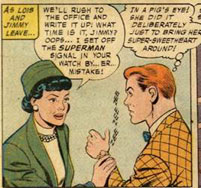
Like to write? Enjoy photography? Want to learn a new computer program? If you answered yes to any of these questions, please join the Guild Communications Committee. We are looking for volunteers who would like to help write, edit and/or produce the Guild enewsletter. Being Superman (or woman) is not necessary - just a desire to be involved. If you are interested, please contact either Judy McKenna, 624-5521, judith.mckenna@comcast.net or Peeps Bogaert, 623-1342, peepsb@comcast.net. We'd love to hear from you. |
|
 The Book Shelf The Book Shelf
What Jane Seney is reading...
I am currently reading the novel Let the Great World Spin by Colum McCann, winner of the National Book Award for Fiction in 2009.
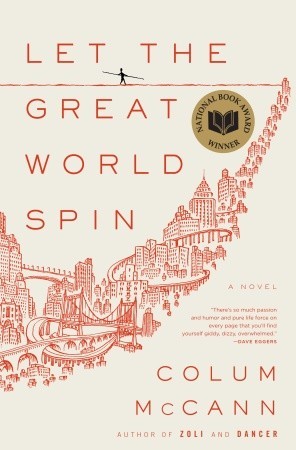 The book is a series of vignettes about the lives of New Yorkers, loosely connected, and anchored by a single spectacular event: Philippe Petit's daring tightrope walk between the World Trade Center towers in the summer of 1974. Petit's walk was recently revisited in the 2009 Academy Award-winning documentary Man on Wire. The book is a series of vignettes about the lives of New Yorkers, loosely connected, and anchored by a single spectacular event: Philippe Petit's daring tightrope walk between the World Trade Center towers in the summer of 1974. Petit's walk was recently revisited in the 2009 Academy Award-winning documentary Man on Wire.
While the book is by no means an examination of the 1970s art world, the art continuously creeps in. One of the stories in the book involves graffiti artists tagging subway cars by making perilous walks into tunnels, along the dangerous third rail, to leave their mark.
There is also a story of a young couple, both artists, consciously trying to carve out their place in the contemporary art world. They are aware of their colleagues' innovations and imitate them out of drug-addled desperation.
One of the main characters is a prostitute. She describes at length the gritty reality of her existence, but then shares an anecdote about encountering Andy Warhol on the street.
In light of Aimie Westphal's and Nina Bozicnik's recent presentations on contemporary art, I've begun to think of Petit's tightrope walk as more than just a circus act, but a real piece of performance art.

Jane Seney, Educator for Tour and Docent Programs
669-6144, x149
jseney@currier.org |
|
Currier Book Group's
Past Selections
|
 Museum Shop News Museum Shop News
New in the shop this spring is jewelry, by the unusually named company called dconstruct, which implants the pieces
 | | Jewelry by dconstruct |
with organic material such as banana fiber, fossil leafs and seaweed.
The jewelry is very light and durable. Also new are one-of-a-kind earrings made from old 35mm film by a Belgian jewelry designer. We've also added new coaster designs by the company, CoasterStone.
The staff and volunteers met in April for the shop's semi-annual meeting and potluck breakfast. Volunteers were brought up-to-date on new merchandise and coming Currier exhibits.
There will be a 30 percent discount in the shop for volunteers from May 6 through 13 for mother's day, and June 10 to 17 for father's day.
We always welcome and value your input.
|
|
Or, use the Guild Room computer the next time you stop in. Click here for Guidelines for Logging Volunteer Hours |
|
2011-2012
Executive Committee
Officers
Executive Chair:
Pat Howard
Executive Vice Chair:
Barbara Shepler
Treasurer:
Ted Parrot
Secretary:
Yvonne Dunham
Committee Chairs
Guild Communications:
Judy McKenna
Pauline Bogaert
Guild Meetings & Programs:
Nancy Johnson
Guild Membership:
Kim Tyndall
Museum Docents:
Carolyn Hollman
Zimmerman House Docents:
Dennie Dyer
Museum Shop:
Richard Russell
Special Projects:
Pam Parrot |
|
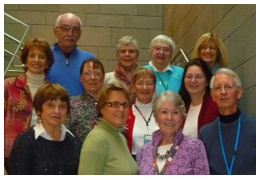
Guild Executive Committee
L to R, back row: Richard Russell, Pauline Bogaert, Frances Gray, Judy McKenna; middle row: Carolyn Hollman, Dennie Dyer, Pam Parrot, Kim Tyndall; front row: Yvonne Dunham, Barbara Shepler, Pat Howard and Ted Parrot. Not shown: Nancy Johnson. |
The Currier Guild in action enewsletter Staff:
Editors: Judy McKenna and Pauline Bogaert
Photo Editor: Anna Zhurbey
Production Assistance: Neva Cole, Michelle Pennington
Special thanks to Carolyn Hollman, Pat Howard and Dennie Dyer for many of the photos in this issue. |
|
 Tips for Viewing and Printing the Guild enewsletter Tips for Viewing and Printing the Guild enewsletter
The Guild enewsletter displays and prints differently depending on the email program and/or internet browser you are using. It is best viewed in the Google Chrome, Mozilla Firefox or Apple Safari browsers. To do so, download one of these programs by clicking on the link, install and make it your default browser, then click on the link at the top of the enews page "Having trouble viewing this email? Click here." The enewsletter will then open in the browser you have chosen.
|
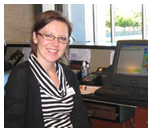 | |
Photo editor: Anna Zhurbey |
|
|
Guild of Volunteers
Annual Report
2010-2011
Click here |
Currier Guild enewsletters Archive
To view a previous enewsletter, click on the desired link: |
| Guild of Volunteers Handbook Online

Ever wonder about the history of the Guild? How the Guild board is structured? What the committees do? The Guild of Volunteers handbook is online with all the answers. To view the Guild Handbook, click here. |
|
|
|
|
Mark your calendars...
Guild of Volunteers
30th Annual Business Meeting and Luncheon
Tuesday, June 5, Manchester Country Club, Bedford
Registration and coffee 9:45 a.m.
Meeting begins promptly at 10:15 a.m.
Guest speakers: Professor Peter J. McGovern and Dr. Catherine Bigley McGovern, Visiting Professors, The Franklin Pierce Center for Intellectual Property at the University of New Hampshire School of Law, on The Museum and the Law.
Invitations to come - please RSVP by May 21 |
Spotlight
Jo Russavage - Treading Softly on the World
When Jo Russavage was asked how often she's moved, she had to think a minute or two. "More than 20 times at least!" It's not the number of times she's moved that is important; it's the wealth of experience she's gained that counts.
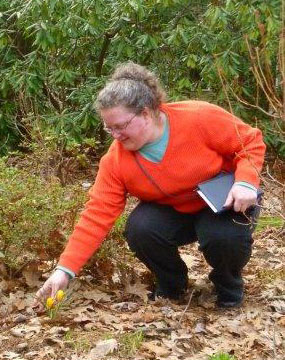 | | Jo Russavage checks out a crocus in the Z-House garden. |
Perhaps the most influential period was the 10 years she spent in Australia. She moved there to be a consultant to a nursery, and later taught at a university. Through the university, she helped design a course for Aborigines - the nation's indigenous people - to be certified in horticulture. In that position, Jo got to live and work in the bush with Aboriginal women. She was "adopted" by an Aboriginal family, where the women called her "sister" or "auntie." As this sister-auntie taught the women, they in turn taught her their lore, skills and art. "I was fascinated by Aboriginal arts," she says, of the painting, weaving and carving crafts. "I learned so much from them ... how to collect fibers, manipulate plants, and use certain plants for dyes."
Jo's fascination with Australia may have started at an early age. "I had this weird little toy platypus I liked as a kid, and the platypus is native to Australia," she says. "I also had a pen pal from Australia."
A native Pennsylvanian, Jo, 52, graduated from Penn State University with a horticulture degree, and then La Salle University for a graduate degree in business. She also trained as a floral designer with the Society of American Florists, the trade organization for the floral industry. She is the fourth oldest of eight children brought up in
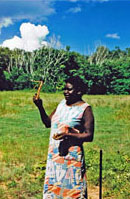 | | Jo's "sister" Rita in Maningrida, Australia. |
Duryea. Her mother was a concert pianist and her father was a teacher. Her mother was also a seamstress and taught Jo to sew. In the 1980s, she attended a trade school and learned to make traditional quilts.
When she first moved to Darwin, Australia, she tried to continue quilting, "but holding a queen-sized quilt on your lap in 95-degree heat is insane," she says, recalling her early days Down Under. Instead she began making small, wall quilts. She joined the Crafts Council of the Northern Territory in Darwin, and "before long I was making my own paper, dying my own fabric with local plants, and learning to weave baskets." Jo eventually became a fiber/mixed media artist combining such things as paper with fabric, making quilts from paper, and weaving plants into quilt blocks.
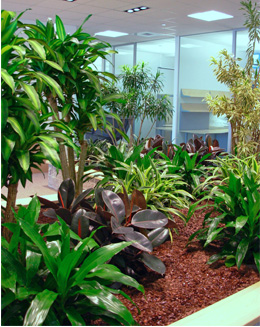 | | An interior landscape by Jo Russavage. |
She came back from Australia in 2000, to visit family and work temporarily at Mugford's Flower Shoppe in Westborough, Mass. "I was waiting for my flight out [to Australia] when they bombed the towers in New York," she says. While waiting to "sort out what to do next," the flower shop offered her a full-time job. After a while, she joined The Westboro Art Gallery, an artists' cooperative in the same town.
In 2009, she moved to Manchester and met neighbor and Currier docent Jane Hill who told her about the coming Zimmerman House docent program. "I said, 'Cool!' I like architecture. I would meet people. The bonus was the house was a Frank Lloyd Wright house."
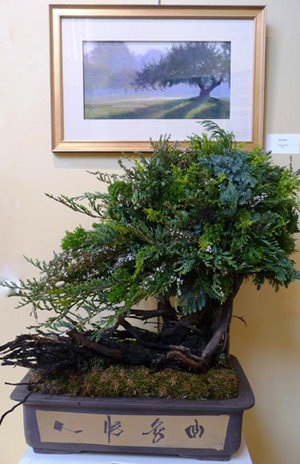 | | Petals to Paint People's Choice Award went to Jo Russavage who paired her arrangement with Dawn Sanel's pastel Solitary. |
"It is such a pleasure to work with Jo," says Educator for Tour and Docent Programs Jane Seney. "She's very dedicated and always willing to share her time and expertise. We're very lucky to have her as a member of the docent corps."
April through November, Jo, who is a New Hampshire Master Gardener and Natural Resources Steward, conducts garden tours at the Z-House. She owns Birchwood Urban Permaculture consulting with private and commercial clients on permaculture, the practice of using environmental techniques that do not deplete the earth's natural resources. She also has joRuss Studio Design, an interior landscape and floral design business, and uses permaculture principles as much as possible. Last fall Jo and several master gardeners used a permaculture technique on the Currier's triangle garden at the corner of Beech and Prospect Streets. The process involved putting wet newspapers around plants, and then placing mulch over the newspaper.
 | | Fish Dreaming, Collograph, 2011 |
In 2011, Jo had 19 pieces of her art in a one-person show called Perma/Culture at the Westboro gallery. In one of her pieces, she used recycled tea bags minus tea leaves, cast-off dryer sheets and worn clothing. Florists usually clip and discard the lily's six anthers, the brownish tips in the flower's middle, but Jo collected these anthers and used them to make dyes.
The fond memory Jo has of Australia, particularly her experience with the Aboriginal bush tribes, has had a long-lasting effect. "They had a reverence for their land as custodians, rather than being owners of it," she says. "Thanks to them, I look at the world differently, tread on it more softly."
- Pauline Bogaert |
|
Volunteers Help for School Vacation Week
Many thanks go to all the people who helped out in late February for school vacation week. Andrew LeBlanc staffed the supply cart for Drawing in the Galleries. Sally Shea and Muriel McMillan helped families as they made art in Family Studio, and Sally and Paula Schmida led family tours. Sean McGovern, Jo Jensen and Marilyn Davison assisted with Storytime. 
Special Projects is now teaming up with the Ambassadors to provide help as needed by the staff. Ambassadors pictured, left to right, rear: Deb Duranceau, Jean Durning, Dot Farley, Mary Christy and Diane DiGerolomo; front: Blanche Friedman and Jo Jensen.

Pam Parrot Special Projects 580-2188 |
|
Museum Docent Report
 Focus on Focus Tours Focus on Focus Tours
From September 2011 through August 2012, museum docents will have conducted 21 different focus tours. Most of these tours have new
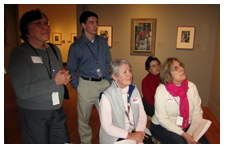 | | At a recent walk through were, l to r, docents Fran Hall, Pat Howard, Julia DiStefano, Nancy Johnson; rear, Jim O'Brien, intern. |
topics, but some successful tours are repeated yearly. All these tours are lively, original and interesting.
Focus tours serve many purposes. According to Jane Seney, focus tours draw returning museum visitors, museum members, and other docents interested in exploring the collection from unique perspectives. These tours are not meant to replace daily, general tours, but provide a deeper or broader experience. They offer a different lens through which repeat visitors can view the collection.
Focus tours offer another way to understand connections among art objects. These connections might not be readily apparent, but, once explored, offer insights and associations that deepen the understanding and appreciation of art.
Focus tours give docents an opportunity to think outside the box, to develop their own ideas, do original research, be creative, and have fun.
Here are some focus tours given so far in 2012:
- Jane Bentas and Pat Howard celebrated Valentine's Day with the "The Love Tour" featuring romance in people portrayed in artwork and artists' lives.
- "Posture and Gesture" by Roberta Lavey explores how these physical bearings communicate attitudes and personality in portraits.
- Jean McGiffin and Kim Tyndall define genre painting through visitor interaction and poetry in their tour called "Art and Poetry: Scenes from Everyday Life."
- Fran Hall creates curatorial ties, among other connections, in "Synergy in Modern and Contemporary Art."
- Judy Ransmeier offers links between the sculptures of Mark di Suvero, Augustus Saint-Gaudens, Harriet Whitney Frishmuth, and Alexander Calder in the "Blowing in the Wind: Kinetic Sculpture."
- Pauline "Peeps" Bogaert tells "How the Currier Got Its Start: Early Acquisitions," with emphasis on the Currier's first director Maud Briggs Knowlton.
If you are interested in developing a focus tour or repeating one of your favorites, contact Jane Seney. Focus tours are publicized through the Currier's regular program brochure, the local press, on museum posters, and on museum docent calendars. Check these sources and plan to enjoy focus tours by fellow docents. 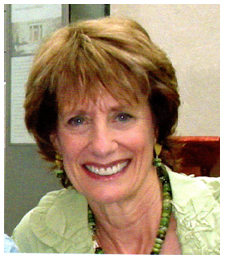 |
|
 Emergency Response Plan in Place Emergency Response Plan in Place
 | | The volunteer and staff evacuation point is the Kennard House at the corner of Beech and Orange Streets. |
Over the last year, Director of Facilities and Operations Nelson Goddard, Registrar Karen Papineau and former Deputy Director Susan Leidy developed an Emergency Response Plan (ERP) for the museum.
The plan conforms to guidelines of the National Incident Management System (NIMS) and created by the Federal Emergency Management Agency (FEMA). It enables staff to handle any kind of emergency in a systematic, organized manner. The standardized national system allows us to easily interface with federal and state agencies to obtain assistance and exchange information.
Certain staff members play leadership roles within the ERP, such as Section Chief and Team Leader and have been certified by FEMA via an online training program. All staff are trained in what role they may play in an emergency and how to use a fire extinguisher. Art-handling training is being scheduled for the near future.
Emergency kits comprised of items that may prove useful in an emergency situation have been prepared and are located in both the museum and the Kennard House. In addition to the ERP, the Art Center has a Response Action Plan that covers emergency procedures specific to schools. The ERP project was a big undertaking, and Nelson and Karen continue to rise to the challenge of ensuring our safety in the event of an emergency.
How does the ERP affect volunteers?
In the event of an emergency, volunteers should defer to security and follow their instructions. If a fire alarm sounds or security issues instructions to evacuate, the volunteer and staff evacuation point is the Kennard House. The visitors' evacuation point is the museum parking lot.
For longer-term emergencies, volunteers may be called upon for assistance and will be incorporated in an orderly, organized fashion.

Michelle Pennington
Associate Educator
(603) 669-6144, ext. 151
mpennington@currier.org |
Zimmerman House Docent Report
 The Wright Vacation - For Rent The Wright Vacation - For Rent
How often have you been in the Zimmerman house and thought: What would it be like to live here? Is the banquette really (un)comfortable? Is the bed really that small? What would it be like eating breakfast in the summertime with the loggia doors open, hearing the birds sing and smelling the flowers?
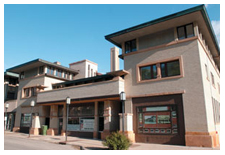 Although it's not possible to occupy the Zimmerman House, there are ways to experience living in a Frank Lloyd Wright house. The Historic Park Inn Hotel in Mason City, Iowa, completed in 1910 has just reopened after a complete renovation. It has 27 modern rooms with high-definition televisions and high-speed Internet. Also included is a conference center, an exercise room, wine room, restored ladies' parlor, gentlemen's lounge, billiards room and bar, and a five-star restaurant. Although it's not possible to occupy the Zimmerman House, there are ways to experience living in a Frank Lloyd Wright house. The Historic Park Inn Hotel in Mason City, Iowa, completed in 1910 has just reopened after a complete renovation. It has 27 modern rooms with high-definition televisions and high-speed Internet. Also included is a conference center, an exercise room, wine room, restored ladies' parlor, gentlemen's lounge, billiards room and bar, and a five-star restaurant.
The Inn at Price Tower in Bartlesville, Okla., was opened in 1956 as a multi-use building containing offices of the H.C. Price Company, as well as offices of insurance agents, dentists, law firms, a women's dress shop and apartments. Today, the occupants of Price Towers are the Price Tower Arts Center, Copper Bar, a museum, H.C. Price offices and a 19-room hotel.
Muirhead Farmhouse is located in a quiet, country setting just northwest of Chicago. The current owners are Mike and Sarah (Muirhead) Petersdorf, the granddaughter of the original owners, Robert and Elizabeth Muirhead. The farmhouse, which is usually operated as a bed and breakfast, is not currently renting rooms. However, tours can be arranged by calling 847-464-5224.
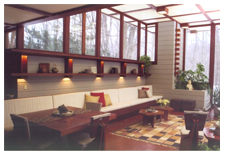 The Louis Penfield House is located in Willoughby, Ohio. After son Paul Penfield inherited and restored the house, he decided to open it to the public. He wanted people to have the luxury of time to sit and savor the house. He wanted visitors to experience the house as a home owner. The three-bedroom house can accommodate up to five people, and a minimum stay of two nights is required. The Louis Penfield House is located in Willoughby, Ohio. After son Paul Penfield inherited and restored the house, he decided to open it to the public. He wanted people to have the luxury of time to sit and savor the house. He wanted visitors to experience the house as a home owner. The three-bedroom house can accommodate up to five people, and a minimum stay of two nights is required.
 The Seth Peterson Cottage is a small cottage in a dramatic wooded setting located in Mirror Lake State Park, Lake Delton, Wis. It was one of Wright's last and smallest commissions which has, according to Wright apprentice Wesley Peterson, "more architecture per square foot than any other building." The cottage sleeps four people and a two-night minimum stay is required. The Seth Peterson Cottage is a small cottage in a dramatic wooded setting located in Mirror Lake State Park, Lake Delton, Wis. It was one of Wright's last and smallest commissions which has, according to Wright apprentice Wesley Peterson, "more architecture per square foot than any other building." The cottage sleeps four people and a two-night minimum stay is required.
Looks like it's time for a road trip!
 Dennie Dyer, Dennie Dyer,
Zimmerman House Docent Chair
434-8794
dennie.dyer@comcast.net
|
 Z-House Reopening Notes Z-House Reopening Notes
The Zimmerman House reopened on Friday, April 13
Two seats on the van will now be reserved for both the van docent and house docent. This way, the house docent knows what has been said riding to the house, so there will be no repeated information in the house presentation. House docents don't have to ride the van, but they should let Jane Seney know as soon as possible so the museum can sell their seat. It's rare, but there will be some public and private tours where a seat for the house docent is unavailable. This will be noted on the WIKI calendar and in direct communication with docents before tour date.
 The museum has a number of plans for Z -House conservation over the next year. Two projects will impact tours this summer: The air conditioning unit will be used, which will make visitors more comfortable and it will help reduce humidity, which causes mold. The museum has a proposal from an HVAC contractor for installing "central" air conditioning in the house. We are in the process of submitting a grant proposal to cover a portion of that expense although additional funding will be needed. It is unlikely we will have funding in place to be able to proceed in time for this summer -- so we will run the portable unit again as unobtrusively as possible during the hottest weather. The museum has a number of plans for Z -House conservation over the next year. Two projects will impact tours this summer: The air conditioning unit will be used, which will make visitors more comfortable and it will help reduce humidity, which causes mold. The museum has a proposal from an HVAC contractor for installing "central" air conditioning in the house. We are in the process of submitting a grant proposal to cover a portion of that expense although additional funding will be needed. It is unlikely we will have funding in place to be able to proceed in time for this summer -- so we will run the portable unit again as unobtrusively as possible during the hottest weather.
The museum is also examining ways to repair some of the concrete blocks, which have cracked. We have a proposal for block crack repair and re-pointing, though it seems that the method is more invasive and more expensive than it needs to be. We will be exploring other options with the contractor and may be doing some test areas in advance of full treatment. This activity is in next year's budget so it is not funding dependent like the air conditioning.
Another project will be the conservation of the wood on the dining loggia doors. One pair of doors will be removed for several days at a time. The project will most likely begin in mid-June and take about two weeks to complete. While it will affect the pristine look of the house during that time, it will provide the opportunity for us to talk about continued efforts to preserve the house, and encourage visitors to return in fall to see the restored doors and house in all its glory.
Jane will develop a video to be played in the Z-House van that docents will have the option of using on tours. Jane is requesting volunteers to help map out what the video will look like. The video group will meet three or four times over the summer.
To keep public tour schedules as consistent as possible, focus tours will start at 3:30 p.m., Thursday through Sunday. If you would like to be on the video committee or have an idea for a focus tour or would like to schedule one, email jseney@currier.org or call Jane Seney, 669-6144, ext. 149.
FLW news: The campus of Florida Southern College in Lakeland, Fla., which has the largest "integrally designed" grouping of buildings by Frank Lloyd Wright on a single site anywhere in the world, was designated a National Historic Landmark (NHL) by Secretary of the Interior Ken Salazar in March. It was one of 13 historic sites chosen in 9 states.
The NHL program, established in 1935, is administered by the National Park Service. The Lakeland buildings are now among the 2,500 listings in the NHL program. |
|
 Museum Seen Museum Seen
The Ecstasy of St. Teresa, Rome
Last summer, I was privileged to travel to the Eternal City during a trip to Europe. In Rome, I experienced the art and architecture I had only read about in many art history classes. I wandered the halls of the Vatican's extensive museum and stood under the ceiling of the awe-inspiring Sistine Chapel. At the last hour of my visit I was able to pay homage to the most exotic and alluring sculpture of the 17th century - The Ecstasy of St. Teresa by Gian Lorenzo Bernini.
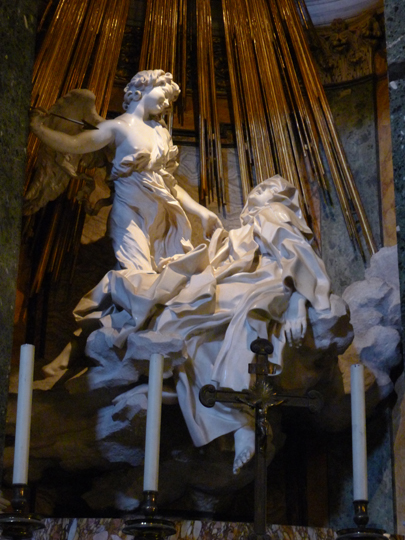 Housed in an unassuming and humble church, the grand sculpture lies in waiting in the Cornaro Chapel, one of three chapels in the Basilica of Santa Maria della Vittoria. As I looked at the basillica's exterior, a mass of scaffolding and chipped stone, I was leery I would find the sculpture I was so excited to see. A moment of disappointment came over me as I wondered if this was the right church. Housed in an unassuming and humble church, the grand sculpture lies in waiting in the Cornaro Chapel, one of three chapels in the Basilica of Santa Maria della Vittoria. As I looked at the basillica's exterior, a mass of scaffolding and chipped stone, I was leery I would find the sculpture I was so excited to see. A moment of disappointment came over me as I wondered if this was the right church.
After being greeted by an elderly woman with a tin cup for offerings, I entered the basillica. I blinked several times to adjust to the light. As I looked at the grandeur of pink and green marble; the vaulted and adorned ceilings; and golden rays and floating angels - I knew this had to be the place!
Tucked in the back, left corner, St. Teresa comes into view and is clearly the cause for the most attention in the room. Bernini brought St. Teresa to life by floating her atop a cloud of marble and wrapping her in mounds of folded fabric. An angelic, human-like cupid has a soft hold upon the statue as if she is to be carried away.
The viewer feels the emotion and spiritual vision that is occuring, and is drawn to the light that defines the folds of fabric framed around her face. Both expressions of the figures and fluidness of their bodies are great examples of the mastery of marble by the artist. Bernini's statue of St. Teresa is clearly one of the greatest examples of Baroque sculpture, and it has been tucked away in its original, modest home for hundreds of years.
The Ecstasy is a must-see for anyone traveling to Rome. A good book featuring this pivotal artwork is Cutting for Stone by Abraham Verghese.
Cornaro Chapel, Santa Maria Della Vittoria[P1] , Via 20 Settembre 17, Repubblica, 00187 Rome
|
|
 The Screening Room The Screening Room
Films on Frank Lloyd Wright
Now that the Zimmerman House is open, we can finish refreshing our memories of all things Wright. Below is the second installment of the Volunteer Video Library's large number of programs related to Wright, his various projects, and his family life.
As a reminder, all the titles in the Volunteer Video Library have been assigned a random identification number. The information below gives only the ID#, title and a brief summary taken from the entries in the three-ring-binder (in the closet), edited for brevity.
#100 - The Architecture of Frank Lloyd Wright A survey of Wright's life and career, from his apprenticeship with Louis Sullivan in Chicago to his final days at Taliesin in Wisconsin.
#102 - Frank Lloyd Wright's Last Dream: The Story of the Monona Terrace The epic 59-year struggle to build one of Wright's most controversial and exciting buildings is told within the context of his life story - tragedies and triumphs, his success and failures.
#103 - Frank Lloyd Wright's 1924 Ennis-Brown House Built in 1924 for retailer Charles Ennis and his wife Mabel, the Ennis House was designed by Frank Lloyd Wright and built by his son, architect Lloyd Wright. The house is the last and largest of the elder Wright's four Los Angeles-area "textile block" houses which feature patterned and perforated concrete blocks that give a unique textural appearance to both their exteriors and interiors.
#105 - 1071 Fifth Avenue: Frank Lloyd Wright and the Story of the Guggenheim Museum Tells the story of the Guggenheim with all the drama, rivalry, bitterness, and achievement of those 17 years and bringing the story up-to-date with the re-opening of the museum after complete restoration and addition.
#106 - The Prarie Homes of Frank Lloyd Wright At the height of the industrial revolution, Wright was the self-proclaimed leader of the 'Prairie School' an influential, forward-looking architectural movement developed in the Midwest. The film explores the interiors and exteriors of these uniquely Midwestern buildings.
#107 - Restoration of Frank Lloyd Wright's Heurtley House This house is considered to be the first fully mature Prairie-style house, but after 95 years, and several owners, it needed major work. An excerpt from the film sleeve says this film "...follows the five-year restoration process, showing the discoveries, obstacles and techniques used to unveil the original face of a masterpiece...."
#111 - Uncommon Places: The Architecture of Frank Lloyd Wright This program features examples of Wright's most well-known buildings which include Fallingwater, The Dana House, Unity Temple, and Taliesen. It includes interviews with many people including Olgivanna Wright.
#112 - The Architecture of Frank Lloyd Wright (Portrait of an Artist series) Recordings of Wright's comments about his work enhance this program which highlights his vision of how space can enhance people's working and living conditions.
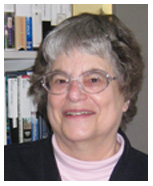
Theia Fischer,
Film writer
883-2102
maydr@localnet.com |
 Dennie and Bill Dyer honored Dennie and Bill Dyer honored
 Z-House Chair Dennie Dyer, and her husband Bill, have been recognized by President Barack Obama and ShelterBox USA with a Presidential Volunteer Service Award for their efforts in 2011 to provide shelter, warmth and dignity for survivors of natural and other disasters worldwide. Z-House Chair Dennie Dyer, and her husband Bill, have been recognized by President Barack Obama and ShelterBox USA with a Presidential Volunteer Service Award for their efforts in 2011 to provide shelter, warmth and dignity for survivors of natural and other disasters worldwide.
The Dyers helped raise awareness and funds for ShelterBox, an international disaster relief charity, which delivers a box containing a family tent, water purification, a cook set and stove along with
 | | Dennie and Bill Dyer assembling a ShelterBox. |
other lifesaving supplies. More than 17,600 ShelterBoxes were supplied to families throughout the world in 2011, including the tornadoes in the southern U.S., drought and famine in East Africa, widespread flooding in the Philippines and earthquakes in Turkey.
"I am truly proud to honor our volunteers, who work hard year-round to support ShelterBox and our efforts to help families rebuild their lives across the globe," said Emily Sperling, ShelterBox USA President. "It's because of the continuous efforts of our volunteers such as Bill and Dennie that we are able to help so many vulnerable families each year." |
|
|
|
|
|
|